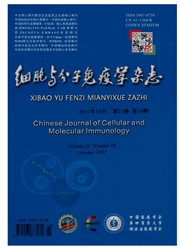

 中文摘要:
中文摘要:
目的探讨氧化型低密度脂蛋白/β2糖蛋白I/抗β2糖蛋白I抗体(oxLDL/β2GPI/β2GPI antibody)复合物促进人脐静脉内皮细胞(HUVEC)迁移和炎症因子的表达以及与Toll样受体4(TLR4)的关系。方法 oxLDL、oxLDL/β2GPI复合物、oxLDL/抗β2GPI抗体复合物、oxLDL/β2GPI/抗β2GPI抗体复合物、脂多糖(LPS)等刺激物处理HUVEC,采用划痕实验观察HUVEC的迁移能力;根据实验分组,收集HUVEC的总蛋白和总RNA,实时荧光定量PCR和Western blot法检测TLR4的mRNA和蛋白表达。利用上述刺激物分别刺激经TLR4抑制剂TAK-242预处理和未经处理的HUVEC,实时定量PCR检测单核细胞趋化蛋白1(MCP-1)、白细胞介素1β(IL-1β)、IL-6的mRNA水平,ELISA检测细胞上清液中MCP-1、IL-1β、IL-6的蛋白水平。结果 oxLDL/β2GPI/抗β2GPI抗体复合物加速HUVEC迁移和诱导TLR4表达,oxLDL/β2GPI/抗β2GPI抗体复合物促进MCP-1、IL-1β、IL-6三种因子的mRNA和蛋白表达,TAK-242能够显著抑制该现象。结论 oxLDL/β2GPI/抗β2GPI抗体复合物促进HUVEC迁移和相关炎症因子的表达,该过程与TLR4密切相关。
 英文摘要:
英文摘要:
Objective To study the effects of the complex of oxidized low density lipoprotein/β2-glycoprotein Ⅰ/β2-glycoprotein Ⅰ antibodies( oxLDL/β2GPI/β2GPI-Ab) on the migration of human umbilical vein endothelial cel s( HUVECs)and the expression of inflammatory cytokines,and their underlying Toll-like receptor( TLR4) pathway. Methods HUVECs were treated with oxLDL, oxLDL/β2GPI complex, oxLDL/β2GPI-Ab complex, oxLDL/β2GPI/β2GPI-Ab complex, or lipopolysaccharide( LPS) for a period of time in their corresponding groups. The migration of HUVECs was observed by the wound-healing assay. The mRNA and protein levels of TLR4 in HUVECs were detected by real-time quantitative PCR( qRT-PCR) and Western blotting,respectively. The cells were pretreated with or without TAK-242( the inhibitor of TLR4) 2hours before stimulated by corresponding stimulus as described above. Then,the contents of monocyte chemotactic protein-1( MCP-1),interleukin 1β( IL-1β) and IL-6 in cell culture supernatant were determined by ELISA,and their mRNAs were detected by qRT-PCR. Results The oxLDL/β2GPI/β2GPI-Ab complex promoted the migration of HUVECs effectively,and increased the expression of TLR4. The oxLDL/β2GPI/β2GPI-Ab complex increased the expressions of MCP-1,IL-1β,and IL-6. TAK-242 could reduce the effects of oxLDL/β2GPI/β2GPI-Ab complex. Conclusion The oxLDL/β2GPI/anti-β2GPI-Ab complex can promote the migration of HUVECs and the expression of related inflammatory cytokines,and TLR4 may be involved in this process.
 同期刊论文项目
同期刊论文项目
 同项目期刊论文
同项目期刊论文
 期刊信息
期刊信息
